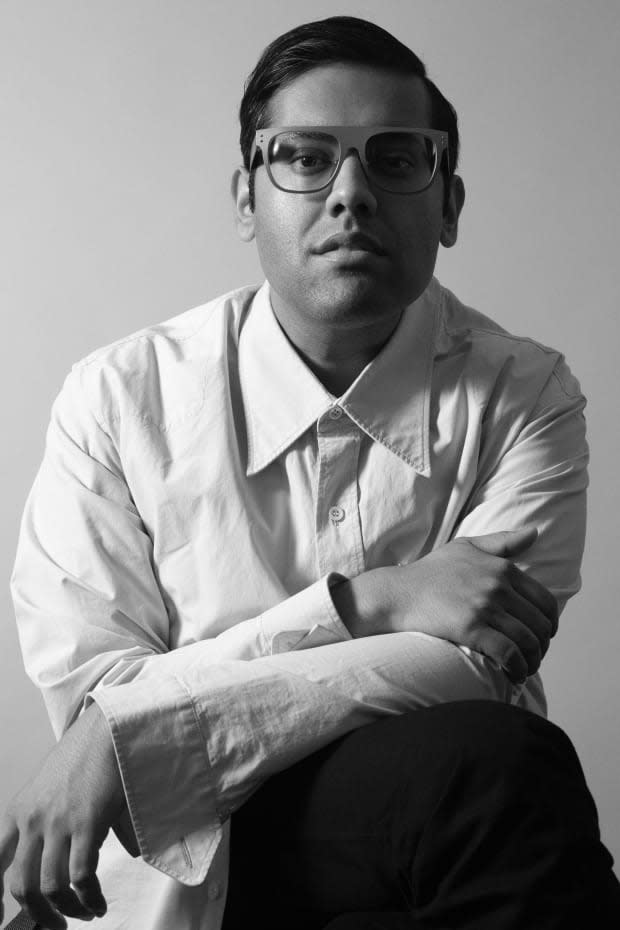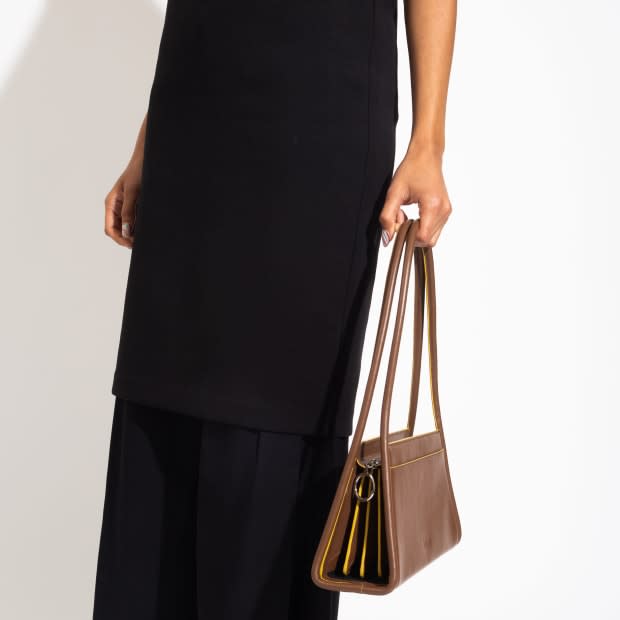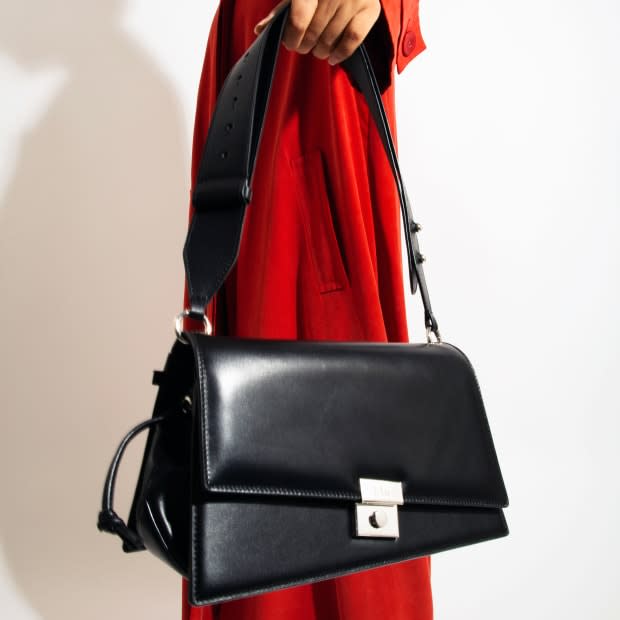How Behno Founder Shivam Punjya Is Proving 'Made in India' Can Be Modern, Minimalist and Ethical

Photo: Courtesy of Behno
In our long-running series "How I'm Making It," we talk to people making a living in the fashion and beauty industries about how they broke in and found success.
What would the fashion world look like if we centered and celebrated the people that labored to physically create product? At Behno, a handbag line founded by Shivam Punjya, we get to see that Utopian ideal as a full-fledged reality. Punjya didn't set out to build a fashion brand, though, but rather something more humble: a factory.
Last week marked 10 years since Rana Plaza, a garment factory in Bangladesh, collapsed, killing more than 1,100 people. It was the deadliest accident in the history of the garment industry. That incident changed the course of Punjya's work and life, eventually putting him on the path to establishing Behno. (The word means "sisters" in Hindi.)
Behno's bags are handmade in India, in factories governed by a set of overarching guidelines called the Behno Standard, which aims to chart a new course in the welfare of workers in the global garment trade by providing them with access to healthcare, family planning, worker mobility and satisfaction and gender rights.
Punjya, who's New York-based, realizes he's part of a very privileged industry: "How do we use this space to make some sort of change when this industry impacts so many people globally?" is a question he's regularly asking himself. "I don't know if this has anything to do with it, but I'm a Cancer," he offers by way of explanation while talking about how he's been emotional since he was a child, impacted by the world's disparities.
Ahead, we talk to Punjya about what he's learnt from putting workers first, Behno's India expansion with a mega Bollywood brand ambassador, how being in New York grounds him and crystallizes his vision and more.

Photo: Courtesy of Behno
How did you find your way into the fashion industry?
I had a very non-traditional journey into fashion. In grad school, I was writing my thesis on folic acid supplementation for women of reproductive age and doing my study in Jaipur and Hyderabad, in India. A lot of our study participants were textile weavers. At the time, I didn't really think much of their livelihood — I was focused on collecting the data for my research. Then, Rana Plaza collapsed. That was a very emotional moment, because just a few months before, I was literally in the field working with a lot of women very similar to those that were murdered in that atrocity. It just shook me up, and it was a little too close to home, even though I spent only six months with the study population.
I was talking about it with my family. I have a big family of two moms and two dads — my mom's younger sister married my dad's younger brother, and we lived in one home in California. It's like a joint family, which used to be very common in India and now is less so, but very uncommon here. My dads essentially gave me one piece of advice: Either you have to make peace with it, or you do something about it.
I was going to go into consulting — had everything lined up — and then decided not to. I wanted to build a factory in India that re-envisioned what traditional manufacturing looks like, and include garment workers and artisans at the center of that narrative.
So you built the back end first?
I always knew that top-down policies are not very effective, especially when community members aren't involved in the conversation. The Behno Standard is bottom-up. I spent about eight months in India visiting factories and talking to garment workers. I then went back to California, lived in libraries and tried to do as much research as I could on what garment workers wanted and valued, rather than what outsiders thought they valued.
What did you hear from workers about what they really wanted?
This was the first time they were even asked what they valued or what mattered to them. That was a huge key takeaway, because it's as simple as engaging someone in a conversation or giving them a seat at the table. Sometimes, a lot of them don't know what to say because they feel this fear of overstepping. There are power dynamics and gender dynamics. While I did some of the focus groups, we also made sure that I wasn't the only one, because I'm still an outsider — a man from California — which also changes the conversation. We wanted to make sure we had key informants.
The things that we thought mattered weren't necessarily the top things they prioritized, because of social dynamics. For example, for us, it was very much about fair wages, but that's like the baseline. That's something most people should already be doing. For them, events like weddings are financially prioritized over healthcare, but when there's a medical emergency, it becomes a financial burden. So [getting them] access to health care clinics was important. It helped us figure out how to use our resources to bridge those gaps, given the nuance of the communities that we're working with.
Could you explain a little bit about how you implement the Behno Standard?
A lot of [factories] are doing good work — it's just about augmenting the social programming they do, or providing a methodology for them to better their practices.
What we implement in the north of India is very different from the south. There are a lot more women working in factories in south India versus the north. Then, the leather industry is very male-driven. It's not a cookie-cutter approach. The Behno Standard has, over time, become a gold standard, like our North Star. That's what we strive for, and then we extract from it whatever is applicable to the different regions and factories that we work with.

Photo: Courtesy of Behno
What was your vision for the design and aesthetic of the brand back then?
I never really envisioned a brand. When we built the factory, a lot of people were concerned about what the factory could manufacture, so we wanted to create a small collection to show what quality our factory could produce. But in that process, we got a little bit of attention — like, 'Oh, this sensibility is interesting.' That's how Behno was born.
There were three presumptions that I kept hearing about Made in India at the time: that it was low quality, created in sweatshops and hippy-dippy in aesthetic. The third presumption was just ignorant to me, because India does phenomenal tailored pieces – we have tailoring houses literally making the world's best pieces for larger brands. I was trying to demonstrate to the world that India can make a minimal, well-constructed product that's not made in a sweatshop.
I also had my own sensibility in terms of design, which was a bit more clinical and modern, wanting to showcase that not everything that comes from India can be pigeonholed into a certain aesthetic.
Our first collection was Fall 2015. It was ready-to-wear, which we did for about five seasons. Then we took a break and pivoted to handbags about four years ago. We started designing handbags just as a stylistic element for lookbooks, but buyers started paying attention to them. We started to realize that our social impact was as important as our financial business, because without us making products that are moving, we're not making a social impact. So we made a 100% pivot to handbags. We now do some ready-to-wear, but it's more curated.
What do you wish the average person on the street knew about the fashion industry and how it works?
It'd be nice if consumers challenged how they approach the 'made in' conversation. A product made in developing countries can be amazing, if not better, than a product that's made in a country in the West that we hold in high [esteem], like Spain, Italy or France.
Something else I would encourage consumers to ask themselves is how often they introduce new pieces into their wardrobe. The 'it' bag should really be seasonless. It's the one in your wardrobe you keep going to over and over. It's nice to celebrate great design, but there's a rat race in our industry to constantly come up with something that's going to break through the noise. We should look at what's been sitting in our wardrobes that we haven't been using, why that's the case and how we can stop making those mistakes.

Photo: Courtesy of Behno
What are the design elements that you put into Behno bags that make them enduring pieces?
Our signature design element is the knot, used in a couple of our bags. At first glance, it's a knot — it's cute. But for us, it's very much a symbol of communities coming together, holding hands.
If you open our bags, the tops of some of the locks are in the shape of a wave, which is a nod towards sustainability. We also have our signature leathers, a pebbled leather and a Nappa leather.
Behno is rooted in minimalism. Our code redefined what new luxury is for us, and that's some combination of impact, heritage and craftsmanship, at this price point. Luxury doesn't have to be a product that's expensive. You can have a luxuriously-made product that's more accessible.
Behno has recently become available in India. Tell us more about the Indian expansion and what white space you hope to fill in that market.
About two years ago, we realized that we have huge engagement from India, both on our site and on social media. And it started to kind of bother me that we weren't distributed in the Indian market. I don't want to call myself colonial, so to speak, but I started wondering, 'What am I really doing with India? I'm manufacturing everything proudly there while focusing on our ethics, but we're extracting. We're not really servicing the Indian client.' So we started thinking about bringing the product in a meaningful way to India.
There are a lot of phenomenal brands in India, but our sense of minimalism and modernism, as well as the quality of the bags at this price point, [is what will set us apart]. We aren't one of those logomania brands. Now people are talking about quiet luxury, and we're more of a quiet luxury brand.
You've also got a huge Bollywood actress, Katrina Kaif, as a brand ambassador and investor. Why was that important?
We realized that in a space like India, we needed an ambassador that was a global citizen. I reached out to Katrina's team with very little expectation, but she was really gracious. We clicked before we even started talking about the business aspect. She was pulling up photo shoots to send references for campaigns — it was really nice to have someone so engaged in that initial conversation. She didn't really know anything about Behno but over time she started to learn a lot and wanted to invest in the company.
She also represents who we are as a brand. We're global in nature. The Indian consumer is very discerning, and that goes back to deep practices that South Asia has had for generations... In India, we have both Western-centric dressing and also a South Asian sense of dressing, and they cross lines all the time.
Do you have any suggestions for other brands who may be wanting to pay similar attention to welfare practices for their workers?
Being on the ground, visiting the factories and spending time in the countries that you're manufacturing in is the most important thing. It's the only way we can have conversations with factory owners and garment workers, to understand what their day to day is. When you're on the factory floor, you see much more than just a product — you're seeing the working relationship. And once we see something, it's hard to unsee it. But if you're sitting behind a computer in New York, you don't see it, and ignorance is bliss.
Never miss the latest fashion industry news. Sign up for the Fashionista daily newsletter.
